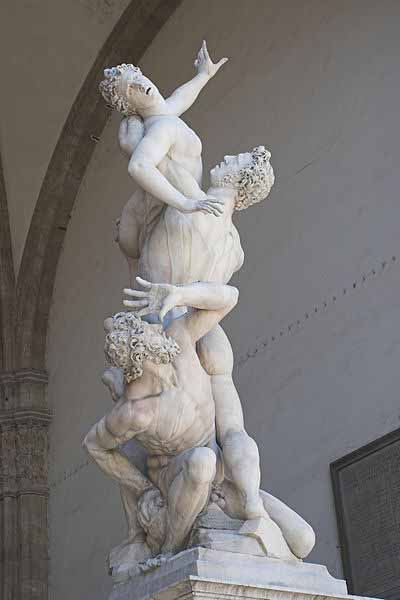

Roman mythology is the body of traditional stories pertaining to ancient Rome's legendary origins and religious system, as represented in the literature and visual arts of the Romans. "Roman mythology" may also refer to the modern study of these representations, and to the subject matter as represented in the literature and art of other cultures in any period.
The Romans usually treated their traditional narratives as historical, even when these have miraculous or supernatural elements. The stories are often concerned with politics and morality, and how an individual's personal integrity relates to his or her responsibility to the community or Roman state. Heroism is an important theme. When the stories illuminate Roman religious practices, they are more concerned with ritual, augury, and institutions than with theology or cosmogony.
The study of Roman religion and myth is complicated by the early influence of Greek religion on the Italian peninsula during Rome's protohistory, and by the later artistic imitation of Greek literary models by Roman authors. The Romans were curiously eager to identify their own gods with those of the Greeks, and reinterpret stories about Greek deities under the names of their Roman counterparts. Rome's early myths and legends also have a dynamic relationship with Etruscan religion, less documented than that of the Greeks.
While Roman mythology may lack a body of divine narratives as extensive as that found in Greek literature, Romulus and Remus suckling the she-wolf is as famous as any image from Greek mythology except for the Trojan Horse. Because Latin literature was more widely known in Europe throughout the Middle Ages and into the Renaissance, the interpretations of Greek myths by the Romans often had the greater influence on narrative and pictorial representations of "classical mythology" than Greek sources. In particular, the versions of Greek myths in Ovid's Metamorphoses, written during the reign of Augustus, came to be regarded as canonical.
Because ritual plays the central role in Roman religion that myth held for the Greeks, it is sometimes doubted that the Romans had much of a native mythology. This perception is a product of Romanticism and the classical scholarship of the 19th century, which valued Greek civilization as more "authentically creative." From the Renaissance to the 18th century, however, Roman myths were an inspiration particularly for European painting.
The Roman tradition is rich in historical myths, or legends, concerning the foundation and rise of the city. These narratives focus on human actors, with only occasional intervention from deities but a pervasive sense of divinely ordered destiny.
In Rome's earliest period, history and myth have a mutual and complementary relationship. Major sources for Roman myth include the Aeneid of Vergil and the first few books of Livy's history. Other important sources are the Fasti of Ovid, a six-book poem structured by the Roman religious calendar, and the fourth book of elegies by Propertius. Scenes from Roman myth also appear in Roman wall painting, coins, and sculpture, particularly reliefs.
The founding of Rome can be investigated through archaeology, but traditional stories handed down by the ancient Romans themselves explain the earliest history of their city in terms of legend and myth. The most familiar of these myths, and perhaps the most famous of all Roman myths, is the story of Romulus and Remus, the twins who were suckled by a she-wolf This story had to be reconciled with a dual tradition, set earlier in time, that had the Trojan refugee Aeneas escaped to Italy and founded the line of Romans through his son Iulus, the namesake of the Julio-Claudian dynasty.
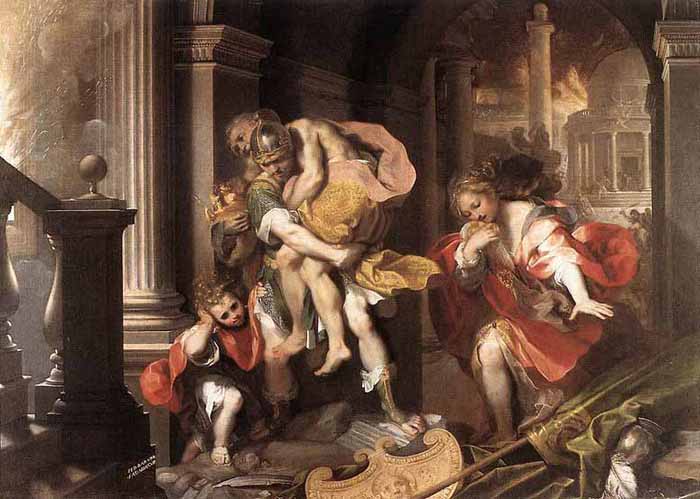
Aeneas flees burning Troy, Federico Barocci, 1598. Galleria Borghese, Rome.
The national epic of Rome, the Aeneid of Virgil, tells the story of how the Trojan prince Aeneas came to Italy. The Aeneid was written under Augustus, who claimed ancestry through Julius Caesar from the hero and his mother Venus.
According to the Aeneid, the survivors from the fallen city of Troy banded together under Aeneas, underwent a series of adventures around the Mediterranean Sea, including a stop at newly founded Carthage under the rule of Queen Dido, and eventually reached the Italian coast.
The Trojans were thought to have landed in an area between modern Anzio and Fiumicino, southwest of Rome: probably at Laurentum, or in other versions, at Lavinium, a place named for Lavinia, the daughter of King Latinus, whom Aeneas married.
Through a series of armed conflicts, the Trojans won the right to stay and to assimilate with the local peoples. The young son of Aeneas, Ascanius, also known as Iulus, went on to found Alba Longa and the line of Alban kings who filled the chronological gap between the Trojan saga and the traditional founding of Rome in the 8th century BC.
Toward the end of this line, King Procas was the father of Numitor and Amulius. At Procas' death, Numitor became king of Alba Longa, but Amulius captured him and sent him to prison; he also forced the daughter of Numitor, Rhea Silvia, to become a virgin priestess among the Vestals. For many years Amulius was then the king. The tortuous nature of the chronology is indicated by Rhea Silvia's ordination among the Vestals, whose order was traditionally said to have been founded by the successor of Romulus, Numa Pompilius
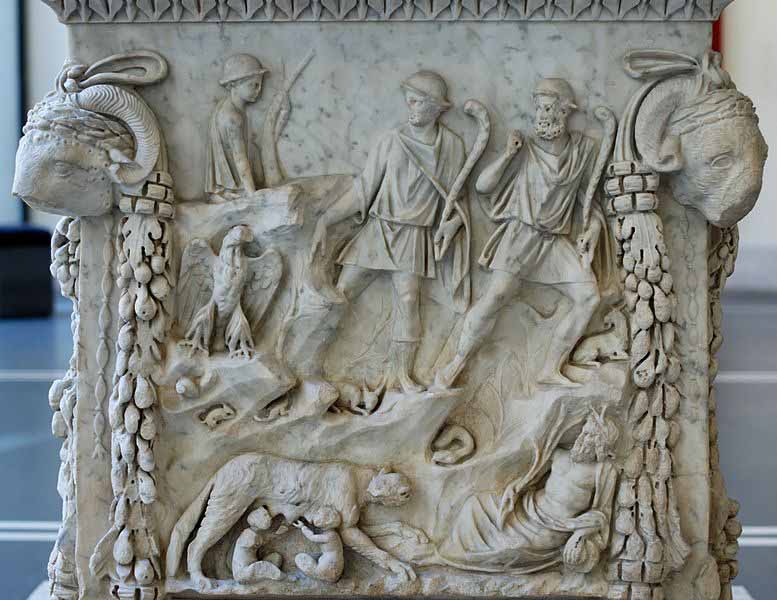
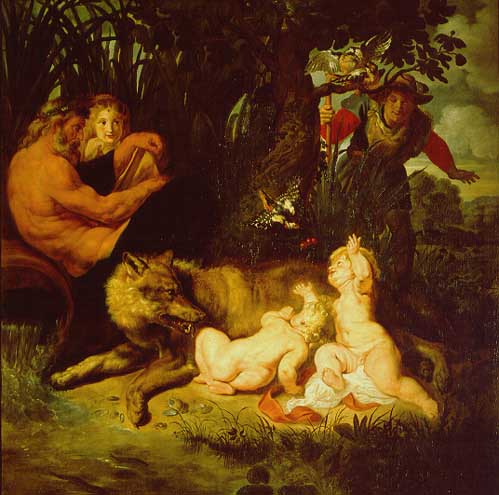
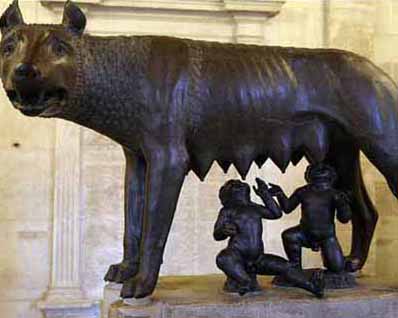
The icon of Rome's foundation, a life-size bronze statue of a she-wolf with two human infants suckling her, is about 1,700 years younger than its city, Rome's officials admitted on Saturday. The official announcement, made at the Capitoline Museums, where the 30 inch-high bronze is the centerpiece of a dedicated room, quashes the belief that the sculpture was adopted by the earliest Romans as a symbol for their city.
There are several variations on the basic legendary tale. Plutarch presents Romulus and Remus' ancient descent from prince Aeneas, fugitive from Troy after its destruction by the Achaeans. Their maternal grandfather is his descendant Numitor, who inherits the kingship of Alba Longa. NumitorŐs brother Amulius inherits its treasury, including the gold brought by Aeneas from Troy. Amulius uses his control of the treasury to dethrone Numitor, but fears that Numitor's daughter, Rhea Silvia, will bear children who could overthrow him.
Amulius forces Rhea Silvia into perpetual virginity as a Vestal priestess, but she bears children anyway. In one variation of the story, Mars, god of war, seduces and impregnates her: in another, Amulius himself seduces her, and in yet another, Hercules.
The king sees his niece's pregnancy and confines her. She gives birth to twin boys of remarkable beauty; her uncle orders her death and theirs. One account holds that he has Rhea buried alive - the standard punishment for Vestal Virgins who violated their vow of celibacy - and orders the death of the twins by exposure; both means would avoid his direct blood-guilt. In another, he has Rhea and her twins thrown into the River Tiber.
In every version, a servant is charged with the deed of killing the twins, but cannot bring himself to harm them. He places them in a basket and leaves it on the banks of the Tiber. The river rises in flood and carries the twins downstream, unharmed.
The river deity Tiberinus makes the basket catch in the roots of a fig tree that grows in the Velabrum swamp at the base of the Palatine Hill. The twins are found and suckled by a she-wolf (Lupa) and fed by a woodpecker (Picus). A shepherd of Amulius named Faustulus discovers them and takes them to his hut, where he and his wife Acca Larentia raise them as their own children.
In another variant, Hercules impregnates Acca Larentia and marries her off to the shepherd Faustulus. She has twelve sons; when one of them dies, Romulus takes his place to found the priestly college of Arval brothers Fratres Arvales. Acca Larentia is therefore identified with the Arval goddess Dea Dia, who is served by the Arvals. In later Republican religious tradition, a Quirinal priest (flamen) impersonated Romulus (by then deified as Quirinus) to perform funerary rites for his foster mother (identified as Dia).
Another and probably late tradition has Acca Larentia as a sacred prostitute (one of many Roman slangs for prostitute was lupa (she-wolf).=
Yet another tradition relates that Romulus and Remus are nursed by the Wolf-Goddess Lupa or Luperca in her cave-lair (lupercal). Luperca was given cult for her protection of sheep from wolves and her spouse was the Wolf-and-Shepherd-God Lupercus, who brought fertility to the flocks. She has been identified with Acca Larentia.
In all versions of the founding myth, the twins grew up as shepherds. They came into conflict with the shepherds of Amulius, leading to battles in which Remus was captured and taken to Amulius, under the accusation of being a thief. Their identity was discovered. Romulus raised a band of shepherds to liberate his brother; Amulius was killed and Romulus and Remus were conjointly offered the crown. They refused it while their grandfather lived, and refused to live in the city as his subjects. They restored Numitor as king, paid due honurs to their mother Rhea and left to found their own city, accompanied by a motley band of fugitives, runaway slaves, and any who want a second chance in a new city with new rulers.
The brothers argued over the best site for the new city. Romulus favored the Palatine Hill; Remus wanted the Aventine Hill. They agreed to select the site by divine augury, took up position on their respective hills and prepared a sacred space; signs were sent to each in the form of vultures, or eagles. Remus saw six; Romulus saw twelve, and claimed superior augury (foresight) as the basis of his right to decide.
Remus made a counterclaim: he saw his six vultures first. Romulus set to work with his supporters, digging a trench (or building a wall, according to Dionysius) around the Palatine to define his city boundary. Remus criticized some parts of the work and obstructed others. At last, Remus leaped across the boundary, as an insult to the city's defenses and their creator. For this, he was killed. The Roman ab urbe condita begins from the founding of the city, and places that date as 21 April 753 BC.
Livy gives two versions of Remus' death. In the one "more generally received", Remus criticizes and belittles the new wall, and in a final insult to the new city and its founder alike, he leaps over it. Romulus kills him, saying "So perish every one that shall hereafter leap over my wall". In the other version, Remus is simply stated as dead; no murder is alleged. Two other, lesser known accounts have Remus killed by a blow to the head with a spade, wielded either by Romulus' commander Fabius (according to St. Jerome's version) or by a man named Celer. Romulus buries Remus with honor and regret.
Romulus completes his city and names it Roma after himself. Then he divides his fighting men into regiments of 3000 infantry and 300 cavalry, which he calls "legions". From the rest of the populace he selects 100 of the most noble and wealthy fathers to serve as his council. He calls these men Patricians: they are fathers of Rome, not only because they care for their own legitimate citizen-sons but because they have a fatherly care for Rome and all its people. They are also its elders, and are therefore known as Senators. Romulus thereby inaugurates a system of government and social hierarchy based on the patron-client relationship.
Rome draws exiles, refugees, the dispossessed, criminals and runaway slaves. The city expands its boundaries to accommodate them; five of the seven hills of Rome are settled: the Capitoline Hill, the Aventine Hill, the Caelian Hill, the Quirinal Hill, and the Palatine Hill. As most of these immigrants are men, Rome finds itself with a shortage of marriageable women.
At the suggestion of his grandfather Numitor, Romulus holds a solemn festival in honor of Neptune (according to another tradition the festival was held in honor of the God Consus) and invites the neighboring Sabines and Latins to attend; they arrive en masse, along with their daughters. The Sabine and Latin women who happen to be virgins - 683 according to Livy - are kidnapped and brought back to Rome where they are forced to marry Roman men.
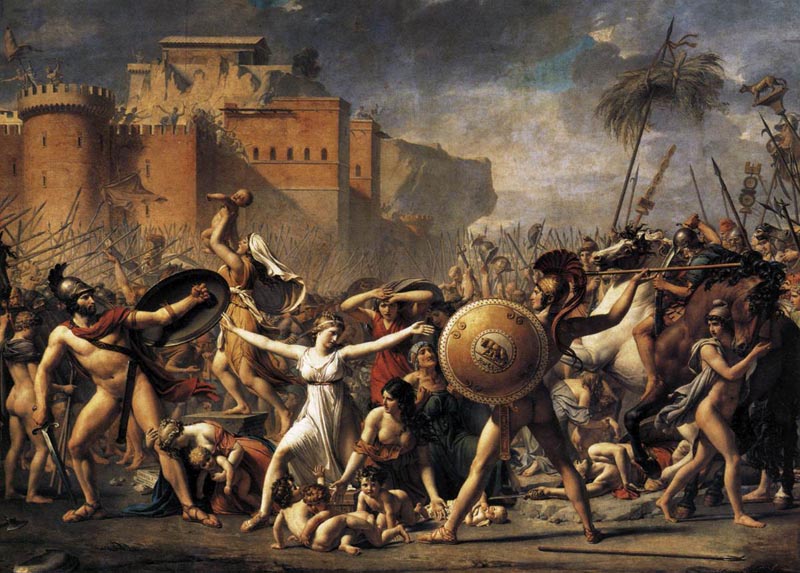
The characteristic myths of Rome are often political or moral, that is, they deal with the development of Roman government in accordance with divine law, as expressed by Roman religion, and with demonstrations of the individual's adherence to moral expectations (mos maiorum) or failures to do so.
Rape of the Sabine women, explaining the importance of the Sabines in the formation of Roman culture, and the growth of Rome through conflict and alliance.
Numa Pompilius, the Sabine second king of Rome who consorted with the nymph Egeria and established many of Rome's legal and religious institutions.
Servius Tullius, the sixth king of Rome, whose mysterious origins were freely mythologized and who was said to have been the lover of the goddess Fortuna.
The Tarpeian Rock, and why it was used for the execution of traitors.
Lucretia, whose self-sacrifice prompted the overthrow of the early Roman monarchy and led to the establishment of the Republic.
Horatius at the bridge, on the importance of individual valor.
Mucius Scaevola ("Lefty"), who thrust his right hand into the fire to prove his loyalty to Rome.
Caeculus was a son of Vulcan and the founder of Praeneste.
Manlius and the geese, about divine intervention at the Gallic siege of Rome.
After the sack of Rome left the plebeians in pitiful condition, they were forced to borrow large sums of money from the patricians, and once again became the poor debtor class of Rome. Manlius, the hero of Rome, fought for them. Livy says, with some inaccuracy, that he was the first patrician to act as a populist (popularis). Seeing a centurion led to prison for debt, he freed him with his own money, and even sold his estate to relieve other poor debtors, while he accused the Senate of embezzling public money. He was charged with aspiring to kingly power, and condemned by the comitia, but not until the assembly had adjourned to a place outside the walls, where they could no longer see the Capitol which he had saved. The Senate condemned him to death in 385 BC, and he was thrown from the Tarpeian Rock one year later. He is considered the second martyr in the cause of social reform at Rome.
His house on the Capitoline Hill was razed, and the Senate decreed that no patrician should live there henceforth. The Manlii themselves resolved that no patrician Manlius should bear the name of Marcus. According to Mommsen, the story of the saving of the Capitol was a later invention to justify his cognomen, which may be better explained by his domicile.
Stories pertaining to the Nonae Caprotinae and Poplifugia festivals.
Coriolanus, a story of politics and morality.
The Etruscan city of Corythus as the "cradle" of Trojan and Italian civilization.
The arrival of the Great Mother (Cybele) in Rome.
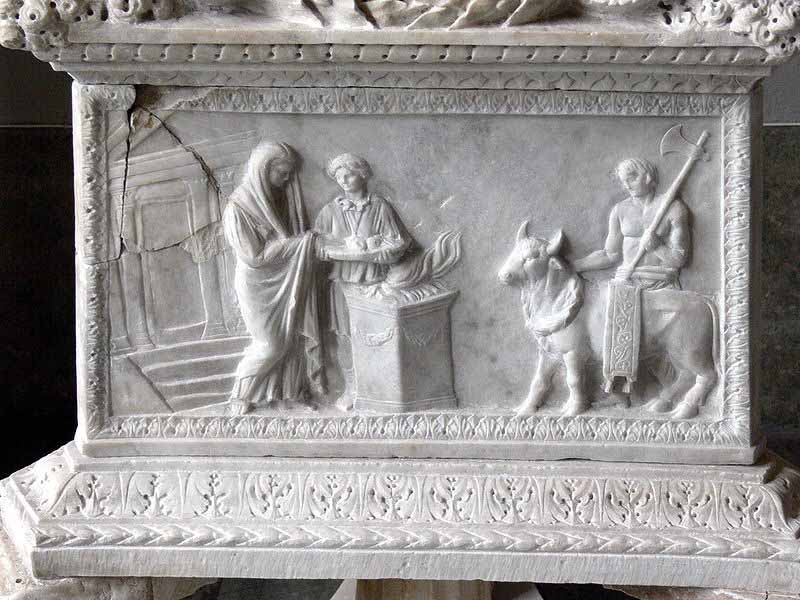
Religion in Ancient Rome
Divine narrative played a more important role in the system of Greek religious belief than among the Romans, for whom ritual and cult were primary. Although Roman religion was not based on scriptures and exegesis, priestly literature was one of the earliest written forms of Latin prose.
The books (libri) and commentaries (commentarii) of the College of Pontiffs and of the augurs contained religious procedures, prayers, and rulings and opinions on points of religious law. Although at least some of this archived material was available for consultation by the Roman senate, it was often occultum genus litterarum, an arcane form of literature to which by definition only priests had access.
Prophecies pertaining to world history and Rome's destiny turn up fortuitously at critical junctures in history, discovered suddenly in the nebulous Sibylline books, which according to legend were purchased by Tarquin the Proud in the late 6th century BC from the Cumaean Sibyl. Some aspects of archaic Roman religion were preserved by the lost theological works of the 1st-century BC scholar Varro, known through other classical and Christian authors.
At the head of the earliest pantheon were the so-called Archaic Triad of Jupiter, Mars, and Quirinus, whose flamens were of the highest order, and Janus and Vesta. According to tradition, the founder of Roman religion was Numa Pompilius, the Sabine second king of Rome, who was believed to have had as his consort and adviser a Roman goddess or nymph of fountains and prophecy, Egeria.
The Etruscan-influenced Capitoline Triad of Jupiter, Juno and Minerva later became central to official religion, replacing the Archaic Triad - an unusual example within Indo-European religion of a supreme triad formed of two female deities and only one male. The cult of Diana was established on the Aventine Hill, but the most famous Roman manifestation of this goddess may be Diana Nemorensis, owing to the attention paid to her cult by J.G. Frazer in the mythographical classic The Golden Bough.
The gods represented distinctly the practical needs of daily life, and they were scrupulously accorded the rites and offerings considered proper. Early Roman divinities included a host of "specialist gods" whose names were invoked in the carrying out of various specific activities. Fragments of old ritual accompanying such acts as plowing or sowing reveal that at every stage of the operation a separate deity was invoked, the name of each deity being regularly derived from the verb for the operation. Tutelary deities were particularly important in ancient Rome.
Thus, Janus and Vesta guarded the door and hearth, the Lares protected the field and house, Pales the pasture, Saturn the sowing, Ceres the growth of the grain, Pomona the fruit, and Consus and Ops the harvest. Even the majestic Jupiter, the ruler of the gods, was honored for the aid his rains might give to the farms and vineyards. In his more encompassing character he was considered, through his weapon of lightning, the director of human activity and, by his widespread domain, the protector of the Romans in their military activities beyond the borders of their own community. Prominent in early times were the gods Mars and Quirinus, who were often identified with each other. Mars was a god of war; he was honored in March and October. Quirinus is thought by modern scholars to have been the patron of the armed community in time of peace.
The 19th-century scholar Georg Wissowa thought that the Romans distinguished two classes of gods, the di indigetes and the di novensides or novensiles: the indigetes were the original gods of the Roman state, their names and nature indicated by the titles of the earliest priests and by the fixed festivals of the calendar, with 30 such gods honored by special festivals; the novensides were later divinities whose cults were introduced to the city in the historical period, usually at a known date and in response to a specific crisis or felt need. Arnaldo Momigliano and others, however, have argued that this distinction cannot be maintained. During the war with Hannibal, any distinction between "indigenous" and "immigrant" gods begins to fade, and the Romans embraced diverse gods from various cultures as a sign of strength and universal divine favor.
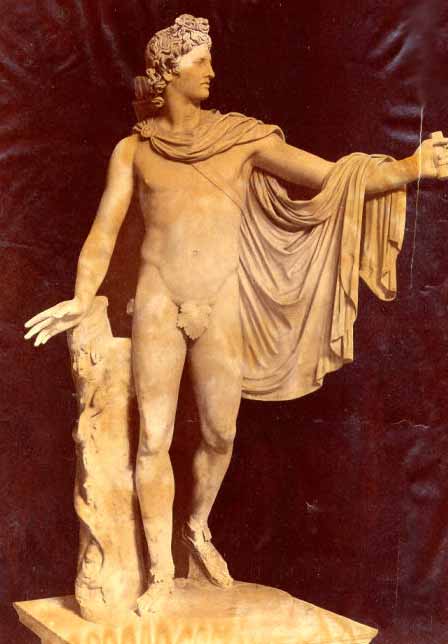
Roman Gods and Goddesses
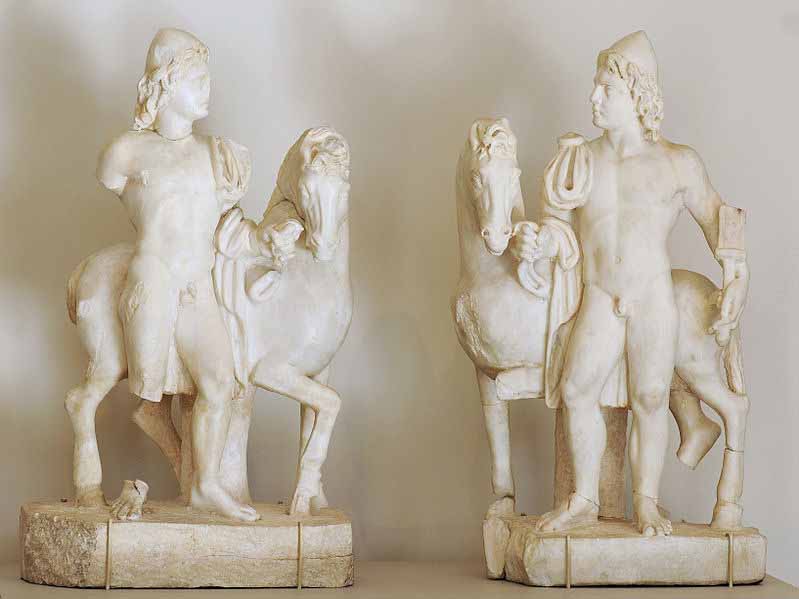
The absorption of neighboring local gods took place as the Roman state conquered the surrounding territory. The Romans commonly granted the local gods of the conquered territory the same honors as the earlier gods of the Roman state religion. In addition to Castor and Pollux, the conquered settlements in Italy seem to have contributed to the Roman pantheon Diana, Minerva, Hercules, Venus, and deities of lesser rank, some of whom were Italic divinities, others originally derived from the Greek culture of Magna Graecia.
In 203 BC, the cult object embodying Cybele was brought from Pessinus in Phrygia and welcomed with due ceremony to Rome, centuries before the territory was annexed formally. Both Lucretius and Catullus, poets contemporary in the mid-1st century BC, offer disapproving glimpses of her wildly ecstatic cult.
In some instances, deities of an enemy power were formally invited through the ritual of evocatio to take up their abode in new sanctuaries at Rome.
Communities of foreigners (peregrini) and former slaves (libertini) continued their own religious practices within the city. In this way Mithras came to Rome and his popularity within the Roman army spread his cult as far afield as Roman Britain. The important Roman deities were eventually identified with the more anthropomorphic Greek gods and goddesses, and assumed many of their attributes and myths.